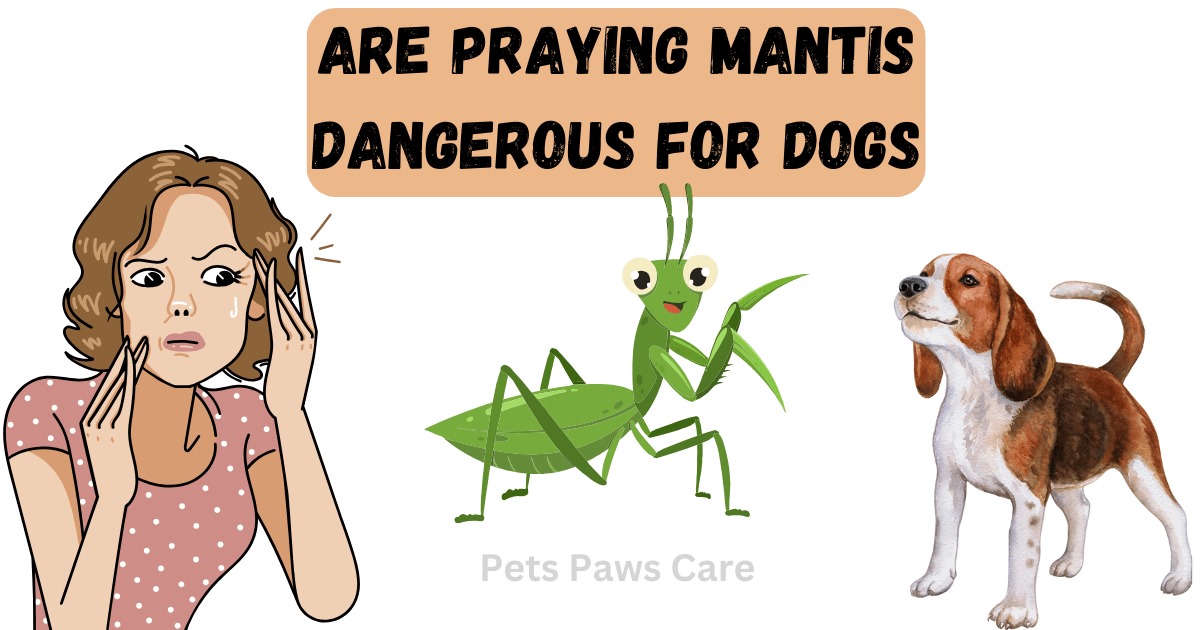Are Praying Mantis Dangerous To Dogs?
Many dog owners wonder if praying mantises are hazardous to their pets. Although mantises might look fierce with their serrated forelimbs, they are not venomous and do not kill or attack dogs. These insects primarily consume other insects and are not a danger to pets.
If a dog becomes too inquisitive with a mantis, it might scratch or bite, but this won’t seriously hurt the dog. Mantises are not poisonous and do not transmit parasites or diseases, so if your pet gets bitten, there’s no major issue. In most situations, mantises are safe around dogs.
Praying Mantis Concerns
When it comes to praying mantises and dogs, there’s little to worry about as they pose minimal risk. Here’s a breakdown of the key information:
Key Points:
- Praying mantises are generally harmless to dogs and do not pose a serious threat.
- They have fierce-looking jaws that can snap, but their bite is not poisonous and won’t break the skin.
- Mantises can cause minor distress or discomfort for curious pets, especially hypersensitive ones like doodle dogs.
- They don’t transmit diseases or cause lasting harm, though they may give off a distasteful odor if crushed.
- These insects can help control harmful bugs such as mosquitoes, flies, and black widow spiders.
While praying mantises can appear threatening with their spikes and leafy-looking appendages which they use in defense since their bite force is too low to seriously harm a dog. They may cause brief nuisance or discomfort while playing outside but are more beneficial in controlling harmful insects around your home.
Is a Praying Mantis Capable of Biting?
A praying mantis may deliver a bite when it perceives a threat, employing its strong serrated mouth-parts to penetrate the skin of humans or dogs. While they are considered non-venomous, and their bite can lead to symptoms like:
- Redness
- Swelling
- Discomfort
- Possible incision
- Need for vet care if harmed
Is it dangerous if a dog eats a praying mantis?
When considering if a praying mantis is dangerous to dogs, their bite is generally harmless. They use serrated mouth parts to grip and catch prey, but they can’t puncture dog or human flesh effectively.
If a mantis feels threatened, it may bite in self-defense, causing mild discomfort like swelling, redness, or a small incision. Even though a praying mantis is non-venomous, it’s still important to monitor the wound for signs of infection, and if it doesn’t heal properly, consult a vet or veterinarian for further care.
Are Praying Mantis Poisonous To Dogs?
Praying mantises, part of the Mantodea order, are not poisonous or harmful to dogs or humans, as they lack any toxins or venom. While they may give a painful bite if mishandled, such as being inappropriately touched or picked up, their small size ensures they pose no serious threat, even if approached or provoked.
Are Praying Mantises Harmful to Humans?
Praying mantises are Mantodean species with bent knees and small size, and they are neither toxic nor venomous to humans or canines. Though not poisonous, they might bite when disturbed or confronted, but these bites are not severe or hazardous. Mishandling, such as improper lifting or stroking, could increase the risk of a defensive reaction, but even then, they pose no real danger.
Do Praying Mantises Make Dogs Envious?
Dogs can become envious or jealous when their human starts paying attention to another species, like a praying mantis. After showing indicators such as growling or aggressive conduct, they might start requesting additional care and cuddles, trying to get more attention from their owner.
Why Do Some Dogs and Praying Mantis Have Such a Tense Relationship?
Some dogs, being curious and playful, often treat bugs like toys for fun. However, they might not realize that a praying mantis can be hostile and potentially dangerous. When dogs are attempting to eat or interact with them, they can be seen provoking these insects, which leads to unexpected tension between the them..
Lifespan Of a Praying Mantis:
The lifespan of a praying mantis varies among different species. The average lifespan for a wild adult female is about two years, while males typically live shorter lives of around 16 years. In captivity, some exceptionally old specimens of praying mantis have been known to live up to 20 years, with the longest-lived documented mantis reaching nearly 30 years, a feat that is quite rare.
Conclusion
This article has compiled every single thing you need to know about praying mantis and how to take care of your dogs to avoid being bitten. While mantis can bite, with extra precautions and by learning their behavior, you can ensure your pet’s safety outdoors and enjoy practically everything nature has to offer.
FAQS
- Is it OK to keep a praying mantis as a pet?
Yes, they can make interesting pets, but require specific care.
- Is praying mantis poisonous?
No, they are non-venomous.
- Can I feed my pet praying mantis?
Yes, they eat live insects, such as fruit flies and crickets.
- Are praying mantis bad to have around?
Generally, no; they can help control pests in gardens.
